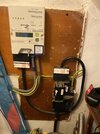Hi
Pretty far down the line with getting an EV charger installed. I’m doing what I can DIY. So the following:
Running all the cabling (6mm 3 core swa), connecting it into the charger which is a Wallbox pulsar plus. No need for earth rods as it’s built in. Cable will be run all the way to the consumer unit.
I’ve attached a picture of the consumer unit and where the main cable comes into the house (on wall adjacent to consumer unit). Assume that I’ll need an rcbo?
I’m aware I’ll need a qualified electrician to connect to consumer unit and fill in the forms. I’ve only got a 60A fuse so need that upgrading.
What rcbo would you recommend?
How much time do you think it would take an electrician to do all the testing, forms and certification? What’s a reasonable going rate for that work in Warwickshire?
Thanks
Pretty far down the line with getting an EV charger installed. I’m doing what I can DIY. So the following:
Running all the cabling (6mm 3 core swa), connecting it into the charger which is a Wallbox pulsar plus. No need for earth rods as it’s built in. Cable will be run all the way to the consumer unit.
I’ve attached a picture of the consumer unit and where the main cable comes into the house (on wall adjacent to consumer unit). Assume that I’ll need an rcbo?
I’m aware I’ll need a qualified electrician to connect to consumer unit and fill in the forms. I’ve only got a 60A fuse so need that upgrading.
What rcbo would you recommend?
How much time do you think it would take an electrician to do all the testing, forms and certification? What’s a reasonable going rate for that work in Warwickshire?
Thanks




